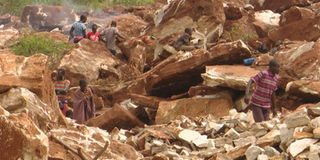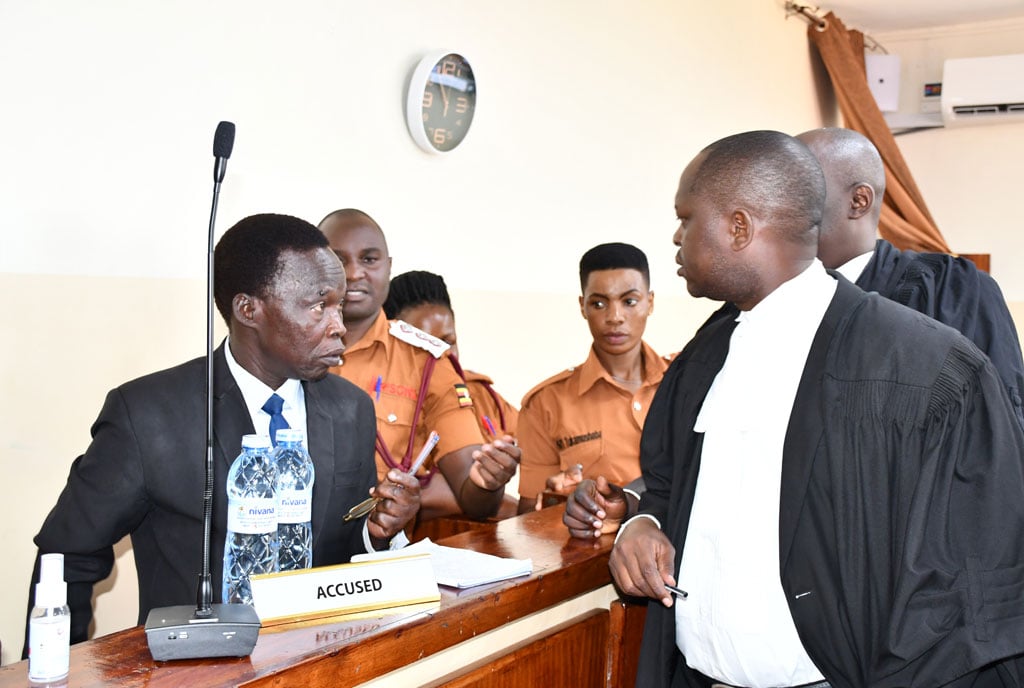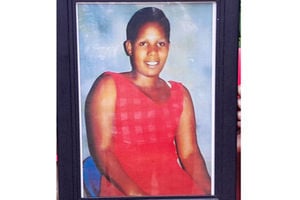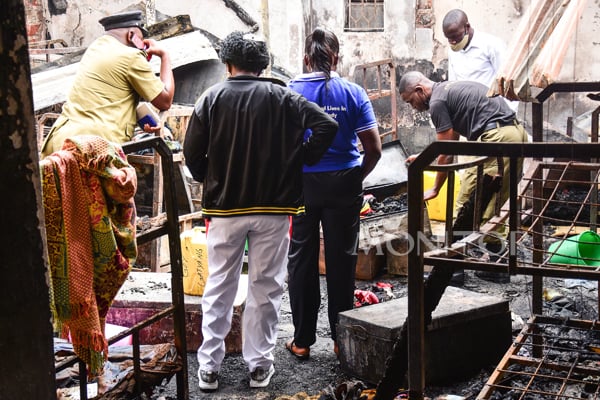Firms scramble for Karamoja’s mineral wealth as locals starve

Efforts. Karimojong work at a stone quarry in Kosiroi Village, Moroto District, on September 13. file PHOTOS
What you need to know:
- Portrayed as a barren and desolate land battered by famine and gun violence that have left hundreds dead, Karamoja is the poster child of the paradox of plenty
- The sub-region, which lies at the northeastern tip of the country, is endowed with mineral wealth
- In the sprawling mines across Karamoja, firms are handing out shovels and sledgehammers to locals in the pursuit of a fortune, a practice akin to a slave-master relationship as Emmanuel Mutaizibwa writes.
In the deeper recesses of Karamoja, a murram road snakes through Kosiroi Village in Moroto District. Across homesteads casting out footpaths, residents trek to limestone pits hidden inside the bowels of the earth.
The trucks that ferry these stones come to a jarring halt upon reaching these grounds.
Barely 20km towards the Kenya border is a site licensed to Tororo Cement Ltd, sitting on 49sq km. Limestone is a carbonate sedimentary rock that has a number of uses, including the production of cement.
Blades of sunlight illuminate the vast expanse as locals with the aid of sledgehammers pound huge boulders out of the earth crust.
At the site are children of school-going age, the old and pregnant women. They barely have any protective gear, often suffering from accidents. They are also exposed to toxic dust and fumes.
“The biggest problems pregnant women suffer goes to the lungs. There are lung changes when a woman gets pregnant. This is meant to allow the amount of oxygen, which the mother will take in and therefore give birth to the baby. But many of these dusts actually damage the lungs, including dust from the rocks. Cancers have been reported such as cancer of the lungs,” Dr Vincent Karuhanga, a physician, says.
Dr Karuhanga says women could suffer from infertility, miscarriages and “children could be born with deformities and breathing complications or their children could have stunted growth”.
The Director for Labour in the Ministry of Gender, Labour and Social Development, Mr Martin Wandera, says: “That is why the issue of occupational health and safety is very critical, more so for young people because their bodies have not developed fully. That is why there are laws in the country regulating the employment of children but also setting standards on occupational safety and health.”
Mr Wandera, however, says the ministry does not have the capacity to monitor every part of the country.
“It is one thing to have laws but you need a continuous process of sensitising or heightening the consciousness of locals about the dangers of certain activities,” he adds.
Back to Kosiroi Village in Moroto District, beads of sweat drip across this woman’s brow as she uses every dollop of energy to break boulders. The younger, energetic men lift the boulders onto the trucks.
To crush and fill a truck full of stones, one is paid between a paltry Shs210,000 and Shs150,000, depending on the size of the truck.
Later, the trucks filled with stones navigate the dicey paths to a nearby parking yard where the stones are kept before they are driven to Tororo Cement in Tororo District, which is about 327km away.
“Since there are no weighbridges in Karamoja, we don’t know how much minerals are leaving Karamoja,” Mr Stephanie Adupa, a civil society activist based in Moroto, says.
Illicit trade
“This is an illicit trade of Karamoja minerals; the traceability [of how much is taken out] is not there,” Mr Andrew Byaruhanga, the executive director of Resource Rights Africa, which is undertaking civic duties in the extractive industry in Karamoja, says.
The political elite in the district provides most of the transport services. Civil society actors in the sub-region believe that the transportation contract Tororo Cement signed with the politicians was meant to buy their silence.
To prove that the locals are paid a pittance, at this Tororo Cement office, petty cash officers are seen giving labourers Shs150,000 for each truck of stones.
Mr David Omido, the logistics and utility manager at Tororo Cement, reveals that they pay the residents for labour because it was their choice.
He also reveals why the company was reluctant to pay for surface rights.
“Generally people don’t want to be paid surface rights because the moment we pay for surface rights, then we have [a right] to mechanise operations. Then the manual labour will not be necessary,” Mr Omido reveals.
“They don’t want surface rights paid unless they are guaranteed that they will receive surface rights and also work. We preferred to pay for surface rights and mechanise operations to be able to get adequate raw materials,” he adds.
Uganda’s mining law requires a surface rights agreement to be negotiated with land owners prior to active mining and payments of royalties to lawful landowners.
Section 98 (2) of the Mining Act, 2003, stipulates that royalties be distributed as follows: central government 80 per cent, local government 17 per cent, and the land owner 3 per cent.
The Act, however, does not clearly address how royalties are collected by the government agencies and how they can follow up with investors regarding what should be allocated to them.
It is not clear how much Tororo Cement paid to acquire this piece of land.
Land issues
“The law is very clear on who owns resources but there are other fundamental rights and entitlements by the local people. If it was compulsory acquisition by government, the process must be followed. This must comply with the provision on prior adequate compensation that before government takes one’s land where there are minerals, there is adequate compensation,” Mr Fredrick Ssemwanga, a lawyer in the extractive industry, says.
Mr Omido reveals that the ancestral owners of the land where their site is located were paid and Tororo Cement has paid billions of shillings in royalties to government.
At Tapac Sub-county headquarters, records of royalties are pinned on the walls. For the first quarter of 2018, Shs55m was paid as royalties while Shs18m was paid for the second quarter. Quarter three and four of 2018 do not indicate how much royalties were paid. For the extractive sector, which is secretive and repels transparency, Mr Ssemwanga says the agreements between companies that own mining leases and government should be subjected to public scrutiny. “The government is only a trustee of these resources. We need transparency or else we shall be compelled to seek public interest litigation,” he says.
Across Tapac over the hills, dark clouds gather.
As the rains pound the landscape, rivers and streams flood, there is a fresh scent of the earth. But the dry season casts a spell on these desolate grounds.
Traditionally, the Karimojong are a semi-nomadic cattle-keeping community whose land is customarily owned. They often raided their neighbours with guns to steal cows. In turn, pastoralist communities from Kenya often crossed the border to raid, resulting in destruction and death.
During conflict, many fled, leaving behind the UPDF and the Catholic Church. A government disarmament programme that commenced in 2002 stripped them of the guns. Speculators rushed to Karamoja as a semblance of peace returned. But extreme climate variability and environmental degradation as a result of mining has made the region’s pastoralist and agro-pastoralist community captive to food insecurity. Famine, followed by starvation and death, has left a trail of death and destruction in Karamoja.
The statistics for Karamoja are grim. A 2018 United Nations Population Fund report titled ‘Leaving No One Behind in Karamoja’ reveals that hunger, stunting and lack of access to food are prevalent.
Karamoja’s collective GDP accounts for less than 1 per cent of Uganda’s total GDP (USAID, 2017), implying that the region’s human capital is not adequately skilled to produce and drive economic growth despite the vast natural resource potential as a cattle corridor and minerals.

At work. Girls carry containers bearing stones in Moroto District.
Poverty levels
The proportion of people trapped in chronic poverty is at 24 per cent, twice higher more the national average of 10 per cent, according to the Uganda National Household Survey 2016/17.
There is limited access to health facilities in Karamoja. The health sector in Karamoja faces challenges of staff retention given its remoteness, poor infrastructure and limited electricity coverage.
Whereas 86 per cent of the Ugandan population accesses healthcare within a 5km radius, in Karamoja, only 17 per cent of the population are within that radius.
Referral is the most affected, with communities having to walk between 20km and 30km to access services.
Though the country has made significant strides in reducing maternal mortality ratio from 529/100,000 live births in 1995 to 336 in 2016, the one for Karamoja has remained persistently high (588/100,000 live births).
All districts in Karamoja except Abim have a very high proportion of children aged six to 12 years who are not in school compared to the national average of 10 per cent. Only 0.9 per cent of children aged six and 12 years are enrolled in primary school, far below the central region at 12 per cent. The overall literacy rate for Karamoja stands at only 25 per cent, compared to 94 per cent in Kampala, while 60 per cent of women in the sub-region are unable to read and write.
So why would an area so rich with mineral wealth be the poorest in the country and lag behind every aspect of the human development index?
If Karamoja were a country, it would be the Democratic Republic of Congo. The sub-region has more than 50 different minerals, including gold, copper, platinum, and lead, in vast amounts. It also has limestone, uranium, marble, graphite, gypsum, iron ore, wolfram, nickel, cobalt, lithium and tin.
“We already knew since years back about the wealth that is buried under our feet. Of course, this by law belongs to the government. But it does this as a trustee to the people. Things are not improving much. We see the people are deprived of their fundamental rights. What could happen is that these people are completely put aside and somebody else takes over these resources,” Moroto Diocese Catholic Bishop Damiano Guzetti says.
But like the foster child of the paradox of plenty, many of the residents are fleeing to escape a life of squalor.
“Karamoja has historically been marginalised and the subsequent governments have not helped much to change the situation. Yet all the indices indicate that people are suffering. There is a lot of extraction driven by the capitalistic nature of extracting these resources not for the benefit the people,” Mr Byaruhanga says.
In every pocket of Karamoja, minerals lie in abundance. And at most mining sites is the sale of local potent gin.
“There is an alcohol problem. Karamoja is one of the sub-regions with the highest consumption of alcohol. Mining activities go hand in hand with illegal alcohol consumption. Can you imagine people were working from morning to evening in exchange for illegal waragi produced along the sugarcane belt of Busoga?” Bishop Guzetti says.
The prelate fears that an entire generation could be lost to alcohol addiction. At this marble site in Rupa Sub-county, a company has fenced off more than 100 acres that previously served as homesteads and grazing lands for the locals.
Sources reveal that the company paid about Shs2b to some members of the local community and elders to acquire a mining lease for this land. But some sections of the community claim that this was not done transparently.
The army is providing security, and movement inside the facility is restricted.
Sunbelt Industries, a company owned by foreign nationals, owns this marble plant. According to the memorandum and articles of association, Sunbelt Industries belongs to Zhu Xu Sheng, who owns 10 per cent shares, and Sun Lian Zhong, who owns 90 percent shares.
Heaps of marble lies abandoned. Locals, who work here and speak off the record, reveal that they do not access the facility where the good quality marble is kept. Some of the marble is exported and a source reveals that tests recently conducted in Italy revealed that it was of the highest quality.
But the operations of this plant are cloaked in secrecy. There are barely any records to show how much marble leaves the plant apart from the occasional appearance of a truck carrying the stones.
Foreign firms
Across Sunbelt Industries on the border of Rupa and Katikekile sub-counties is the defunct DAO Uganda Ltd, which was a subsidiary of a Saudi and Kuwaiti construction firm. It acquired an exploration licence in 2013. In its blueprint, Dao planned to ship marble blocks to Europe and Middle East.
But five years down the road and after piling debt worth billions of shillings, including loans from commercial banks, the owners of Dao marble vanished without a trace.
Was there any due-diligence carried out to ascertain the credibility of the owners? In September last year, the company claimed it would embark on a $40 million expansion plan for its processing plant. Was this a decoy to give its owners enough time to flee the shackles of the law?
The acquisition of the land where the Dao marble plant lies was also contested. Many residents, including elders, felt they had been locked out of the negotiations yet they had a stake.
“Licensing in the sector is opaque. Instead of engaging the local communities, instead of engaging local government, that does not happen. Companies come from the centre and by-pass communities and are fencing off people’s land without proper consultation of the community,” Mr Byaruhanga says.
Mr Ssemwanga says since the discovery of minerals in Karamoja, land speculators have emerged and have surveyed land belonging to the local communities. “Locals should survey their land and get their certificates of title. It will be very difficult for someone to come and say ‘this is my land’ because records will indicate the owner of the land,” he argues. Pushed out by a punishing lifestyle, locals continue to flee in droves.
Among the victims are children who have been trafficked to Kampala. With their begging bowls, they fill the streets of the city.
Growth index
Poverty. The proportion of Karimojong trapped in chronic poverty is at 24 per cent, twice higher more the national average of 10 per cent, according to the Uganda National Household Survey 2016/17.
Literacy. The overall literacy rate for Karamoja stands at only 25 per cent, compared to 94 per cent in Kampala, while 60 per cent of women in the sub-region are unable to read and write. Eighty six per cent of the young population in Karamoja have never been to school.




